Abstract
ASYMMETRIC divisions that produce two distinct cells play fundamental roles in generating different cell types during development1,2. In the Drosophilacentral nervous system, neural stem cells called neuroblasts divide unequally into another neuro-blast and a ganglion mother cell which is subsequently cleaved into neurons. Correct gene expression of ganglion mother cells requires the transcription factor Prospero3á¤-5. Here we demonstrate the asymmetric segregation of Prospero on neuroblast division. Prospero synthesized in neuroblasts is retained in the cytoplasm and at mitosis is exclusively partitioned to ganglion mother cells, in which it is translocated to the nucleus. Differential segregation of Prospero was also found in the endoderm. We have identified a region in Prospero that is responsible for this event. The region shares a common motif with Numb6, which also shows unequal segregation7. We propose that asymmetric segregation of transcription factors is an intrinsic mechanism for establishing asymmetry in gene expression between sibling cells.
This is a preview of subscription content, access via your institution
Access options
Subscribe to this journal
Receive 51 print issues and online access
$199.00 per year
only $3.90 per issue
Buy this article
- Purchase on Springer Link
- Instant access to full article PDF
Prices may be subject to local taxes which are calculated during checkout
Similar content being viewed by others
References
Horvitz, H. R. & Herskowitz, I. Cell 68, 237–255 (1992).
Greenwald, I. & Rubin, G. M. Cell 68, 271–281 (1992).
Doe, C. Q., Chu-LaGraff, Q., Wright, D. M. & Scott, M. P. Cell 65, 451–464 (1991).
Vaessin, H. et al. Cell 67, 941–953 (1991).
Matsuzaki, F., Koizumi, K., Hama, C., Yoshioka, T. & Nabeshima, Y. Biochem. biophys. Res. Commun. 182, 1326–1332 (1992).
Uemura, T., Shepherd, S., Ackerman, L., Jan, L. Y. & Jan, Y. N. Cell 58, 349–360 (1989).
Rhyu, M. S., Jan, L. Y. & Jan, Y. N. Cell 76, 477–491 (1994).
Spana, E. P. & Doe, C. Q. Development (in the press).
Skaer, H. in The Development of Drosophila melanogaster 941–1021 (Cold Spring Harbor Laboratory Press, New York, 1993).
Driever, W. & Nüsslein-Volhard, C. Cell 54, 83–93 (1988).
Warton, R. P. & Struhl, G. Cell 67, 955–967 (1991).
Gavis, E. R. & Lehmann, R. Cell 71, 301–313 (1992).
Gavis, E. R. & Lehmann, R. Nature 369, 315–318 (1994).
Evans, T. C., Crittenden, S. L., Kodoyianni, V. & Kimble, J. Cell 77, 183–194 (1994).
Curtis, D., Lehmann, R. & Zamore, P. D. Cell 81, 171–178 (1995).
St Johnston, D. Cell 81, 161–170 (1995).
Geisler, R., Bergmann, A., Hiromi, Y. & Nüsslein-Volhard, C. Cell 71, 613–621 (1992).
Beg, A. A. & Baldwin, A. S. Jr Genes Dev. 7, 2064–2070 (1993).
Ihle, J. N. et al. Trends biochem. Sci. 19, 222–227 (1994).
Pratt, W. B. et al. Cancer Res. 49, 2222–2229 (1989).
Zinman, M. et al. Molec. biol. Cell 4, 1307–1316 (1993).
Guo, S. & Kemphues, K. J. Cell 81, 611–620 (1995).
Lawrence, P. & Morata, G. Cell 78, 181–189 (1994).
Finney, M. & Ruvkun, G. Cell 63, 895–905 (1990).
Campos-Ortega, J. & Hartenstein, V. The Embryonic Development of Drosophila melanogaster (Springer, Berlin, 1985).
Tepass, U. & Hartenstein, V. Development 121, 393–405 (1995).
Thummel, C. S., Boulet, A. M. & Lipshitz, H. D. Gene 74, 445–456 (1988).
Author information
Authors and Affiliations
Rights and permissions
About this article
Cite this article
Hirata, J., Nakagoshi, H., Nabeshima, Yi. et al. Asymmetric segregation of the homeodomain protein Prospero duringDrosophila development. Nature 377, 627–630 (1995). https://doi.org/10.1038/377627a0
Received:
Accepted:
Issue Date:
DOI: https://doi.org/10.1038/377627a0
This article is cited by
-
Baf-mediated transcriptional regulation of teashirt is essential for the development of neural progenitor cell lineages
Experimental & Molecular Medicine (2024)
-
Mxc, a Drosophila homolog of mental retardation-associated gene NPAT, maintains neural stem cell fate
Cell & Bioscience (2022)
-
An intrinsic mechanism controls reactivation of neural stem cells by spindle matrix proteins
Nature Communications (2017)
-
The structural basis of Miranda-mediated Staufen localization during Drosophila neuroblast asymmetric division
Nature Communications (2015)
Comments
By submitting a comment you agree to abide by our Terms and Community Guidelines. If you find something abusive or that does not comply with our terms or guidelines please flag it as inappropriate.



